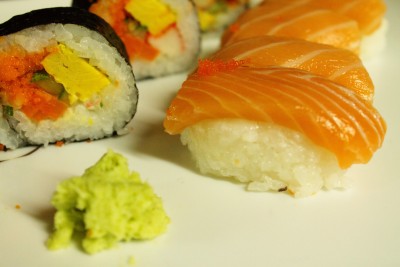Wasabia japonica
Welcome! This website is dedicated to the herb called Wasabia japonica, or wasabi. Within this webpage you will find information regarding wasabi's taxonomic classification, habitat, adaptation to its habitat, nutrition, reproduction, and interactions with other organisms. But first, here is a little background knowledge and fun facts.
Wasabi is a perennial herb indigenous to Japan, but can also be found in eastern Siberia. It is mainly harvested in the wild , but has been known to be cultivated in Japan, North America and New Zealand, although it is said to be rather difficult to grow. It has thick stems and large, round leaves and white flowers resembling those of horseradish. Because it is similar in taste and appearance, the herb is often called Japanese horseradish.
Wasabi is an important garnish to many traditional Japanese dishes, including raw fish, tempura, and noodle dishes, and can either be used in its fresh form or it can be processed into pastes and powders. The parts of this plant used to create these forms are the roots and stem bases. Since it is a relatively scarce commodity, wasabi is expensive and is often faked by coloring horseradish green. Because of its pungent taste, it is only used in small amounts. The sharp taste and extreme flavoring of the herb is due to isothiocyante compounds, which neutralize carcinogens.
